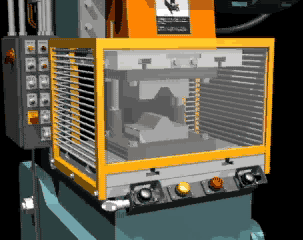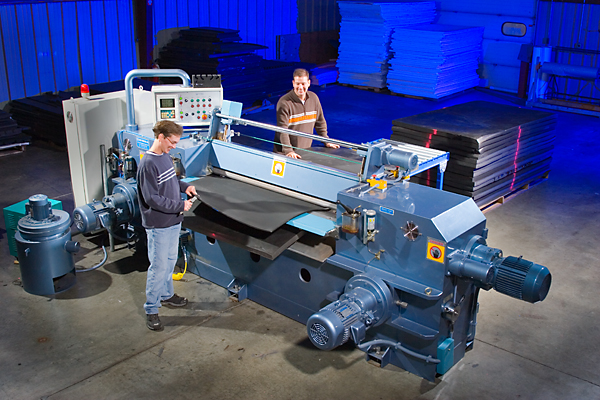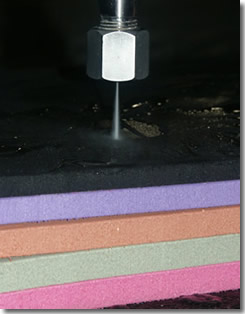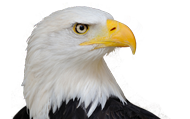Die Cutting
 Ideal for high volume repeating applications GWEP has a full range of die cutting capabilities to include the precision kiss cutting of parts with pressure sensitive adhesive.
Ideal for high volume repeating applications GWEP has a full range of die cutting capabilities to include the precision kiss cutting of parts with pressure sensitive adhesive.
Our die cutters operate similar to a large-scale cookie cutter. They are capable of cutting exact shapes out of foam. Dies, also known as plates, are made by insetting thin, finely serrated blades into wood to create a cutting pattern. Sheets of foam are placed over the plates and compressed by up to 80 tons of pressure. The foam is forced down over the plates, cut to shape and released, creating a form matching the plate’s exact design.
Fast Wire Cutting
 Our Fastwire cutters allow us to cut a complex profile in a wide variety of materials up to 60” long. Common applications are rack cladding or pipe insulation.
Our Fastwire cutters allow us to cut a complex profile in a wide variety of materials up to 60” long. Common applications are rack cladding or pipe insulation.
Skiving
 GWEP's skivers allow us to cut our foams, into sheets as thin as 1/16 of an inch and as thick as 5 inches.. The skiver shaves foam into layers or slices. Because of the density of the materials cut with the skiver, the blade is a substantial one, at 3.3 inches wide, .04 inches thick and constantly self-sharpening. Considering the materials it must cut, the skiver is incredibly powerful.
GWEP's skivers allow us to cut our foams, into sheets as thin as 1/16 of an inch and as thick as 5 inches.. The skiver shaves foam into layers or slices. Because of the density of the materials cut with the skiver, the blade is a substantial one, at 3.3 inches wide, .04 inches thick and constantly self-sharpening. Considering the materials it must cut, the skiver is incredibly powerful.
The machine is manually fed and can handle widths up to 76 inches, with no limit to the length of the sheet. For especially long sheets, the skiver can be fed from rollers. The skiver needs to be programmed to cut to a certain thickness, but not to the degree of a CNC machine or the waterjet cutter, as the saw blade remains stationary once programmed to its desired setting. Since the skiver can only cut horizontally, products may be cut to size on vertical saws, waterjet cutters or die cutters. Products produced from the skiver include high-density packaging, flotation devices like life jackets and sports matting and padding.
Waterjet Cutting
 Our waterjet cutter uses the power of highly pressurized, abrasive–free water and the precision of computer programming to create products that require a high degree of detail. With a jet of water pressurized at 60,000 psi, traveling at three times the speed of sound, we are able to cut through foam products up to 4 inches thick. For perspective, the cutter is able to slice through a 1/2 inch piece of plywood on our standard foam-cutting settings with a jet only .005 inches in diameter. After a pattern is programmed, the foam sheet to be cut is placed on a bed of 7 inch corrugated plastic that diffuses the jet’s stream. The nozzle hovers over the sheet, tracing the form’s outline with the jet, cutting through the foam cleanly.
Our waterjet cutter uses the power of highly pressurized, abrasive–free water and the precision of computer programming to create products that require a high degree of detail. With a jet of water pressurized at 60,000 psi, traveling at three times the speed of sound, we are able to cut through foam products up to 4 inches thick. For perspective, the cutter is able to slice through a 1/2 inch piece of plywood on our standard foam-cutting settings with a jet only .005 inches in diameter. After a pattern is programmed, the foam sheet to be cut is placed on a bed of 7 inch corrugated plastic that diffuses the jet’s stream. The nozzle hovers over the sheet, tracing the form’s outline with the jet, cutting through the foam cleanly.
While they both provide the same level of precision, the waterjet cutter is for lower volume products than the die cutter. This is because the time it takes to trace every cut takes minutes, while a single pressing on the die cutter takes seconds. However, because the waterjet cutter requires only computer programming, it carries a shorter lead-time than the die cutter, and is costs less than creating press plates. Waterjet projects are typically limited volume products like prototypes, specialized packaging forms, gaskets and toys.
Assembly
Lorem ipsum dolor sit amet, consectetuer adipiscing elit. With our vast experience of bonding foam. Great Western Eagle Packaging is well suited to use the most cost effective method to bond your projects.
PSA Application
With our vast experience of bonding foam. Exemplary is well suited to use the most cost effective method to bond your parts.
Post Processing
This term captures an infinite array of activities once the basic shape of the part is cut. This includes, T-slotting, shaping, taping, as well as drilling and countersinking holes amongst others.

